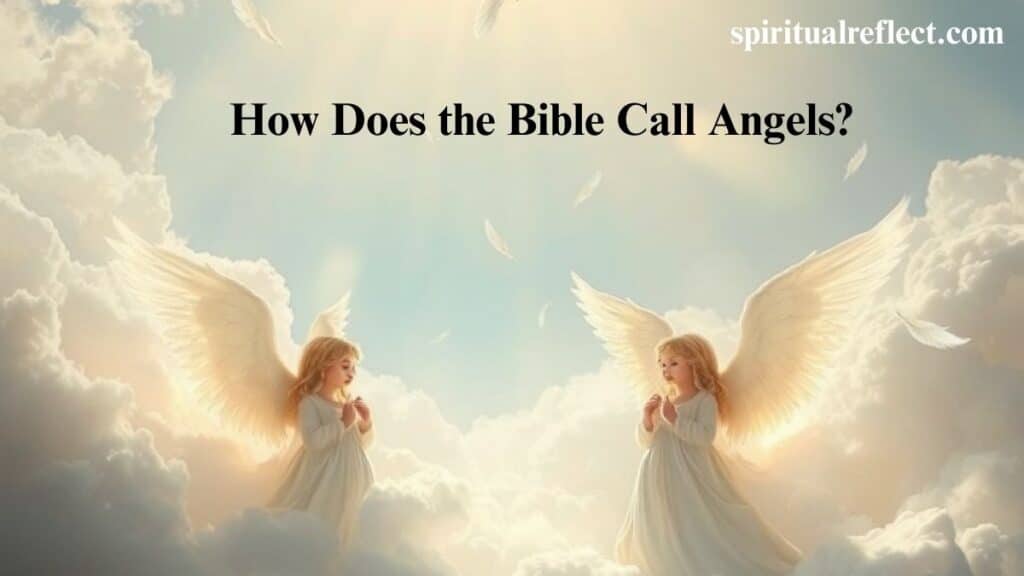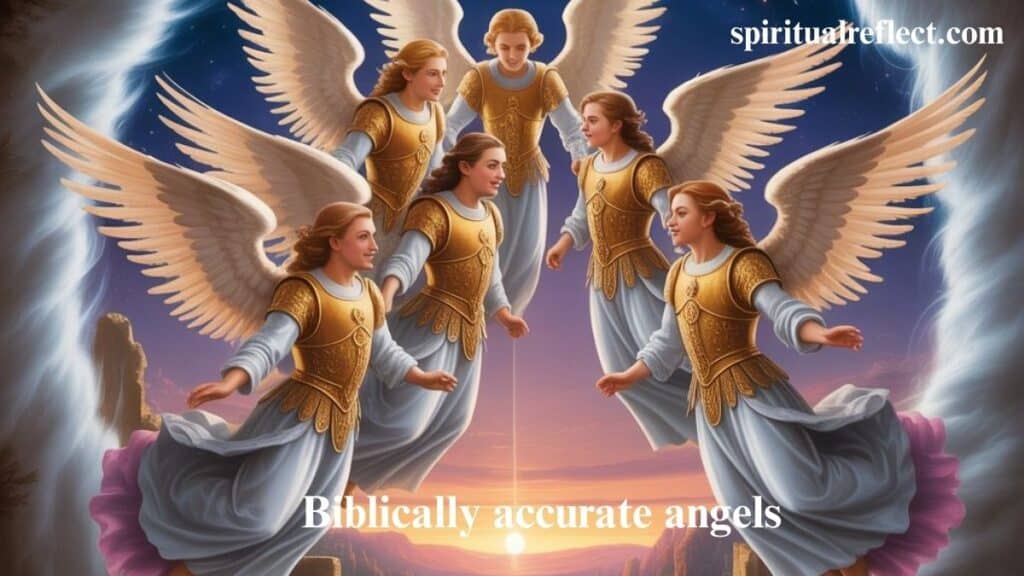Biblically accurate angels are depictions of celestial beings based on the descriptions found in the Bible, particularly in books such as Ezekiel, Isaiah, and Revelation. Unlike the familiar winged, humanlike figures often portrayed in art, these representations emphasize the strange, awe-inspiring, and sometimes terrifying imagery found in scripture—wheels within wheels, multiple faces, and bodies covered in countless eyes. These beings serve as messengers, warriors, and servants of God, radiating divine authority and power.
Far from the gentle, haloed figures seen on greeting cards, Biblically accurate angels are visions of overwhelming majesty that can inspire both wonder and fear. Their otherworldly appearance challenges human imagination and draws curiosity toward the mysteries hidden within ancient texts. Encountering their descriptions is like stepping into a realm where reality bends to divine will.
In exploring Biblically accurate angels, one uncovers a rich tapestry of symbolism and meaning. These beings reflect not only the might of God but also the complexity of His creation, embodying roles that range from protectors and heralds to agents of divine judgment. Their descriptions reveal the depth of biblical literature and offer a glimpse into a spiritual dimension far beyond human understanding.
What Are Angels in the Bible?
Angels in the Bible serve as God’s messengers, warriors, and servants. The Hebrew word “mal’ak” and the Greek word “angelos” both mean “messenger” or “envoy.” These spirit beings bridge the gap between heavenly realms and earth.
Biblical texts describe angels as created beings with specific roles in God’s plan. They’re not omnipresent like God, but they possess supernatural abilities that far exceed human capacity.
Key Characteristics of Biblical Angels
Spiritual beings in Scripture share several important traits:
- Intelligence: Angels understand God’s will and carry out complex missions
- Power: They can influence physical reality and battle supernatural beings
- Holiness: Most angels remain faithful to God’s purposes
- Immortality: Scripture presents angels as eternal beings who don’t die naturally
Angels aren’t human souls who’ve earned wings. They’re a completely separate order of creation with their own purpose in God’s kingdom.
How Does the Bible Call Angels?

Scripture uses various terms to describe angels in the Bible, each revealing different aspects of their nature and function.
Hebrew Terms for Angels
| Hebrew Word | Meaning | Usage |
|---|---|---|
| Mal’ak | Messenger, envoy | General term for angels |
| Seraphim | Burning ones | Throne guardians who worship God |
| Cherubim | To grasp or guard | Celestial guardians of sacred space |
| Sons of God | Divine beings | Members of divine council |
| Watchers | Those who watch | Angels who observe humanity |
Greek Terms for Angels
The New Testament primarily uses “angelos” (messenger) but also employs:
- Archangelos: Chief messenger or archangel
- Pneumata: Spirits
- Leitourgika pneumata: Ministering spirits
- Dynameis: Powers or mighty ones
These terms reveal angels’ multifaceted roles in biblical prophecy and salvation history.
Description of Angels in the Bible
Angelic appearances in Scripture often shock and terrify witnesses. Far from gentle guardians, these encounters reveal an overwhelming divine presence.
Physical Descriptions
Biblical prophecy books offer the most detailed descriptions:
Ezekiel’s Vision (Ezekiel 1:4-14):
- Four living creatures with human-like forms
- Four faces: human, lion, ox, and eagle
- Four wings and bronze-like feet
- Hands under their wings on all four sides
- Bodies full of eyes
- Moving like lightning between them
Isaiah’s Seraphim (Isaiah 6:2-3):
- Six wings each
- Two wings covered their faces
- Two wings covered their feet
- Two wings for flying
- Called “Holy, holy, holy” continuously
- Voices shook the temple foundations
Common Elements in Angel Descriptions
Symbolism of wings, fire, and light appears throughout angelic appearances:
- Fire: Represents God’s judgment and purification
- Wings: Symbolize speed, freedom, and divine intervention
- Eyes: Show omniscience and constant watchfulness
- Light: Reflects holy presence and glory
These elements emphasize angels in dreams and visions as representatives of God’s awesome power.
List of Biblically Correct Angels

Scripture names relatively few angels specifically, but those mentioned play crucial roles in salvation history.
Named Angels in Canonical Scripture
- Michael – “Who is like God?”
- Gabriel – “God is my strength”
- Satan – “Adversary” (before his fall)
Angels Named in Deuterocanonical Books
Book of Tobit and other texts include:
- Raphael – “God heals”
- Uriel – “Fire of God”
- Raguel – “God’s vengeance”
- Sariel – “God’s command”
Angels Named in Book of Enoch
While not canonical, Enoch provides additional names:
- Remiel – “Thunder of God”
- Raziel – “Secret of God”
- Camael – “He who sees God”
These names reveal angelic names and meanings that emphasize their relationship to divine attributes.
Biblically Accurate Archangels
Archangels represent the highest-ranking angels in the Bible. These divine messengers lead the heavenly host and carry out God’s most important missions.
Michael: The Warrior Prince
Michael appears as God’s premier warrior throughout Scripture. Daniel calls him “one of the chief princes” and “the great prince who stands watch over your people.”
Key Michael Appearances:
- Daniel 10:13 – Fights spiritual warfare against demonic princes
- Daniel 12:1 – Stands guard over Israel during end times
- Jude 1:9 – Disputes with Satan over Moses’ body
- Revelation 12:7-9 – Leads war against Satan in heaven
Michael’s role emphasizes spiritual warfare and the protection of God’s people. His name, meaning “Who is like God?”, challenges Satan’s prideful rebellion.
Gabriel: The Divine Messenger
Gabriel serves as God’s primary messenger for major announcements. This archangel delivers news that changes salvation history.
Gabriel’s Major Messages:
- Daniel 8:16-26 – Explains the vision of the ram and the goat
- Daniel 9:21-27 – Reveals prophecy of seventy weeks
- Luke 1:11-20 – Announces John the Baptist’s birth to Zechariah
- Luke 1:26-38 – Announces Jesus’ birth to Mary
Gabriel’s appearances often involve messianic prophecy and God’s redemptive plan unfolding through history.
Raphael: The Divine Healer
Raphael appears primarily in the Book of Tobit, where he guides Tobias and heals his father’s blindness. His name means “God heals,” reflecting his role in divine intervention for physical and spiritual restoration.
Raphael’s Functions:
- Healing physical ailments
- Guiding travelers safely
- Binding demonic forces
- Revealing God’s mercy
Though not mentioned in the Protestant canon, Raphael represents God’s healing power working through angelic ministry.
Cherubim: The Throne Guardians
Cherubim guard sacred space and God’s throne. These celestial guardians appear throughout Scripture as protectors of divine holiness.
Cherubim in the Garden of Eden
Genesis 3:24 places cherubim east of Eden with flaming swords, preventing access to the Tree of Life after humanity’s fall. This establishes their role as guardians of holy presence.
Cherubim in the Tabernacle
God commanded cherubim figures to be placed on the Ark of the Covenant (Exodus 25:18-22). These golden figures faced each other with wings spread over the mercy seat, where God’s presence dwelt among Israel.
Ezekiel’s Living Creatures
Ezekiel’s vision reveals cherubim as complex beings:
Physical Features:
- Four faces (human, lion, ox, eagle)
- Four wings
- Straight legs with calf-like feet
- Human hands under wings
- Bodies covered in eyes
- Wheels within wheels beside them
These descriptions emphasize cherubim as living throne room imagery surrounding God’s mobile throne.
Cherubim’s Symbolic Meaning
Cherubim represent:
- God’s absolute holiness
- Angel-human boundary that sin created
- Divine justice protects sacred things
- Participating in God’s kingdom through proper reverence
Seraphim: The Fiery Servants

THE Seraphim appear only in Isaiah 6:1-7, where they surround God’s throne in heavenly worship and praise. Their name means “burning ones” or “fiery serpents.”
Isaiah’s Vision of Seraphim
Isaiah saw seraphim with six wings each:
- Two wings covered their faces – showing reverence before God’s glory
- Two wings covered their feet – demonstrating modesty in holy presence
- Two wings for flying – enabling swift service
The Seraphim’s Holy Song
Seraphim continuously call out:
“Holy, holy, holy is the LORD of hosts; the whole earth is full of His glory!” (Isaiah 6:3)
This heavenly worship and praise caused the temple to shake and fill with smoke, demonstrating God’s overwhelming majesty.
Cleansing Ministry
One seraphim took a live coal from the altar and touched Isaiah’s lips, declaring:
“Behold, this has touched your lips; your iniquity is taken away, and your sin purged.” (Isaiah 6:7)
This reveals the seraphim’s role in purification and preparation for divine intervention.
Angels in the Book of Revelation
Revelation contains Scripture’s most extensive angelic activity. These apocalyptic visions show angels executing God’s judgment during the end times.
The Seven Angels with Trumpets
Revelation 8-11 describes seven angels with trumpets bringing divine judgment:
| Angel | Trumpet Judgment | Result |
|---|---|---|
| First | Hail, fire, blood | 1/3 of the Earth burned |
| Second | 1/3 of Earth burned | Burning mountain cast into the sea |
| Third | Star Wormwood falls | 1/3 of water becomes bitter |
| Fourth | 1/3 of the sun, moon, and stars struck | Darkness |
| Fifth | Abyss opened | Demonic locusts released |
| Sixth | 1/3 of the sea becomes blood | 200 million horsemen kill 1/3 |
| Seventh | Voices in heaven | God’s kingdom proclaimed |
The Seven Bowl Judgments
Revelation 16 shows seven angels pouring out God’s wrath:
These judgments demonstrate angels as instruments of divine justice in the cosmic battle between good and evil.
Other Notable Revelation Angels
- Angel with the eternal gospel (Revelation 14:6)
- Angel who measures the temple (Revelation 11:1)
- Angel who binds Satan (Revelation 20:1-3)
- Angel who shows New Jerusalem (Revelation 21:9)
Watchers in the Bible

THE Watchers represent a special class of angels mentioned in Daniel and expanded in the Book of Enoch. These beings observe humanity and report to the divine council.
Watchers in Daniel
Daniel 4:13-17 describes Nebuchadnezzar’s dream of a watcher:
“I saw in the visions of my head while on my bed, and there was a watcher, a holy one, coming down from heaven.”
This watcher pronounces judgment on the king, demonstrating their role in executing divine decrees over earthly rulers.
The Fallen Watchers
Book of Enoch describes watchers who rebelled against God by:
- Descending to earth
- Taking human wives
- Teaching forbidden knowledge
- Producing giant offspring (Nephilim)
While Enoch isn’t canonical, Genesis 6:1-4 hints at similar events when “sons of God” married “daughters of men.”
Watchers’ Functions
Biblical watchers serve as:
- Observers of human behavior
- Executors of divine judgment
- Guardians of cosmic order
- Participants in divine council decisions
Their rebellion illustrates the tragedy of spiritual beings choosing evil over good.
Guardian Angels

THE Guardian angels protect and guide individuals throughout their lives. This concept appears throughout Scripture, though not always explicitly labeled.
Biblical Foundation for Guardian Angels
Matthew 18:10 provides the clearest reference:
“Take heed that you do not despise one of these little ones, for I say to you that in heaven their angels always see the face of My Father who is in heaven.”
This suggests children have guardian angels who maintain constant access to God’s presence.
Examples of Guardian Angel Activity
Scripture shows angels protecting individuals:
- Angel prevents Abraham from sacrificing Isaac (Genesis 22:11-12)
- Angel guards Lot’s family during Sodom’s destruction (Genesis 19:15-16)
- Angel protects Daniel in the lions’ den (Daniel 6:22)
- Angel frees Peter from prison (Acts 12:7-10)
Guardian Angels vs Popular Culture
Biblical guardian angels differ from popular depictions:
Biblical Reality:
- Powerful spiritual beings
- Execute God’s specific will
- May appear terrifying
- Focus on spiritual protection
Popular Culture:
- Gentle, human-like appearance
- Personal wishes granted
- Always a comforting presence
- Focus on material comfort
Understanding guardian angels requires recognizing their primary loyalty to God, not human desires.
Angel of the LORD
The Angel of the LORD appears throughout the Old Testament as a mysterious figure who seems to be both distinct from and identical with God himself.
Unique Characteristics
The Angel of the LORD differs from other angels:
- Accepts worship (forbidden for regular angels)
- Speaks as God in the first person
- Bears God’s name fully
- Exercises divine prerogatives
Key Appearances
Major Angel of the LORD encounters:
| Passage | Person | Significance |
|---|---|---|
| Genesis 16:7-14 | Hagar | Called “God who sees me” |
| Genesis 22:11-18 | Abraham | Prevents Isaac’s sacrifice |
| Exodus 3:2-6 | Moses | Burning bush theophany |
| Judges 6:11-24 | Gideon | Commission as deliverer |
| Judges 13:3-22 | Manoah | Announces Samson’s birth |
Theological Significance
Many scholars identify the Angel of the LORD as pre-incarnate Christ – the second person of the Trinity appearing before the incarnation. This explains how the figure can be both angel and God simultaneously.
Evidence for Pre-incarnate Christ Theory:
- Accepts worship
- Bears divine names and attributes
- Speaks with full divine authority
- Disappears after Christ’s incarnation
This connection links Old Testament angelic appearances with the New Testament revelation of the Trinity.
Fallen Angels
Fallen angels chose rebellion over obedience, following Satan in his war against God. These beings represent the tragic potential of created beings to reject their Creator.
Satan: The Chief of Fallen Angels
Satan was originally a cherub of the highest order (Ezekiel 28:12-19). His pride led to his downfall:
“Your heart was lifted up because of your beauty; you corrupted your wisdom for the sake of your splendor.” (Ezekiel 28:17)
Satan’s rebellion triggered the great cosmic battle between good and evil that continues today.
The Great Rebellion
Revelation 12:7-9 describes the war in heaven:
“And war broke out in heaven: Michael and his angels fought with the dragon; and the dragon and his angels fought, but they did not prevail, nor was a place found for them in heaven any longer.”
This passage reveals that one-third of angels followed Satan in rebellion (Revelation 12:4).
Consequences of Rebellion
Fallen angels face eternal judgment:
- Cast out of heavenly realms
- Bound in chains of darkness (2 Peter 2:4)
- Await final judgment (Jude 1:6)
- Continue opposing God’s people (Ephesians 6:12)
Demons vs Fallen Angels
Scripture suggests fallen angels and demons may be different entities:
Fallen Angels:
- Originally created as angels
- Rebelled with Satan
- Bound or limited in activity
- Await judgment
Demons:
- Possibly spirits of deceased Nephilim
- Seek to possess humans
- Actively oppose God’s work
- Led by fallen angels
This distinction explains the different types of spiritual warfare believers encounter.
Names of Biblically Accurate Angels
Angelic names and meanings reveal important aspects of their character and function in God’s plan.
Canonical Angel Names
Scripture provides limited but significant angelic names:
| Name | Meaning | Primary Role |
|---|---|---|
| Michael | “Who is like God?” | Warrior, protector of Israel |
| Gabriel | “God is my strength” | Divine messenger, announcer |
| Satan | “Adversary” | Rebel, deceiver, accuser |
Deuterocanonical Angel Names
Book of Tobit and other texts add:
| Name | Meaning | Primary Function |
|---|---|---|
| Raphael | “God heals” | Healer, guide, demon-binder |
| Uriel | “Fire of God” | Punisher, guardian of gates |
| Raguel | “God’s vengeance” | Divine justice executor |
| Sariel | “God’s command” | Divine will communicator |
Names from the Book of Enoch
While not canonical, Enoch provides additional insight:
- Remiel – “Thunder of God” – Divine judgment
- Raziel – “Secret of God” – Divine mysteries
- Camael – “He who sees God” – Divine strength
These names emphasize angelic roles as extensions of God’s attributes and purposes.
The Role of Angels in Salvation History
Angels in the Bible participate throughout salvation history, from creation to final judgment. Their involvement demonstrates God’s care for humanity and his cosmic plan of redemption.
Angels in Creation and Early History
Scripture implies angelic involvement in creation itself:
“Where were you when I laid the foundations of the earth… when the morning stars sang together, and all the sons of God shouted for joy?” (Job 38:4, 7)
This suggests angels witnessed and celebrated creation, establishing their role as supporters of God’s work.
Angels in Israel’s History
guided Israel through crucial moments:
- Angel led Israel through the wilderness (Exodus 23:20)
- Angels gave the Law at Sinai (Acts 7:38, 53)
- Angel stopped plague in Jerusalem (2 Samuel 24:16)
- Angels protected and guided prophets
Angels in Christ’s Ministry
surrounded Jesus throughout his earthly life:
- Announced his birth (Luke 2:8-14)
- Ministered after temptation (Matthew 4:11)
- Strengthened him in Gethsemane (Luke 22:43)
- Announced resurrection (Matthew 28:5-7)
In the Angels, the Church Age
Angels continue serving believers:
- Provide protection (Psalm 91:11)
- Deliver messages (Acts 8:26)
- Minister to saints (Hebrews 1:14)
- Observe church gatherings (1 Corinthians 11:10)
In Angels’ End Times
Revelation shows angels executing the final judgment and establishing God’s eternal kingdom. Their role culminates in the complete victory of good over evil.
Contrast with Popular Culture Depictions
Understanding biblically accurate angels requires recognizing how far modern culture has strayed from scriptural truth.
Popular Culture Angels
Modern depictions typically show:
- Human-like appearance with feathered wings
- Gentle, non-threatening demeanor
- Personal wish-fulfillment focus
- Individualistic rather than God-centered
Biblical Reality
Scripture reveals angels as:
- Often terrifying in appearance
- Focused on God’s glory, not human comfort
- Powerful spiritual beings with cosmic responsibilities
- Part of the heavenly hierarchy serving divine purposes
Why the Difference Matters
Contrast with popular culture depictions affects how people:
- Understand God’s power and holiness
- Approach spiritual warfare
- View their place in God’s cosmic plan
- Prepare for divine intervention
Biblical understanding produces reverence, while cultural versions promote comfortable but false expectations.
Conclusion
Biblically accurate angels are far more than simple symbols of kindness or beauty. They are powerful and strange beings, created to serve God in ways beyond human understanding. Their shapes, filled with eyes, wings, and light, remind us that heaven is not always gentle or familiar. Biblically accurate angels. They show the glory and greatness of God’s power.
Learning about Biblically accurate angels can change how we see the spiritual world. These beings are not made to comfort us but to carry out God’s will with strength and purpose. Their presence in the Bible teaches respect, awe, and faith. They stand as a reminder that the divine is far greater, stranger, and more powerful than we can imagine. ultimate authority over all heavenly realms and earthly affairs.

Rana Ahmad is the creator of Spiritual Reflect, where she shares insights on personal growth, mindfulness, and meaningful living to inspire a more intentional life.







